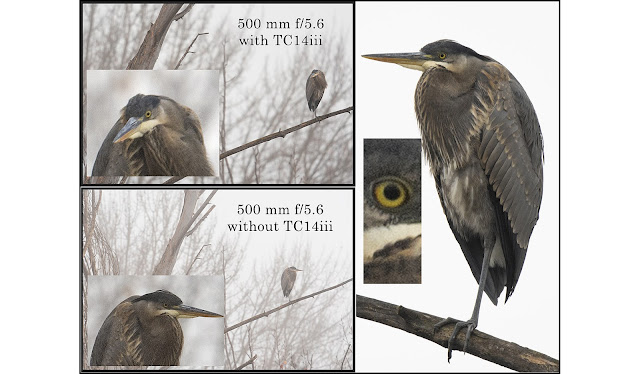Teleconverters - the TC14E III by Nikon - a field test.
 |
| Great blue heron shot with (above and right) and without (below) a teleconverter. |
A teleconverter is a lens accessory that fits between a camera's lens and its body. It has optical-quality glass elements in it, usually 7, and magnifies the focal length of the attached lens. There are three common strengths, 1.4x, 1,7x, and 2x. I have seen 3x teleconverters but they are rare.
The upside to a teleconverter, as you can guess, is that it magnifies your image, it gives you more resolving power. The downside is two-fold. First, you lose light, a full stop for a 1.4x TC and two stops for a 2x TC. That is going to mean slower shutter speeds or higher ISOs. The second issue is that your image is degraded because of the glass elements. Although Nikon's TC14E III is exceptional, the image still loses about 5% of its quality.
I used the TC on my 500mm PF Nikkor prime lens with a minimum aperture of f/5.6. The 1.4x TC gives a 40% boost to the focal length that now comes in at 700mm. The APS-C camera I used (my D500) has a crop factor of 1.5 so that produces a relative focal length of 1050 mm - essentially equivalent to the power of a 21x binoculars or scope. I noticed right away how much larger the birds I sought looked inside the viewfinder. It was significant.
However, I increased the ISO to 400 in the somewhat mitigated lighting (it was foggy) because the minimum aperture was now f/8. Cameras have a hard time with high minimum apertures because the amount of light coming into the system prevents accurate focusing and metering. The D500 had no problem with either function under the test conditions. The focus speed was as fast and accurate as I have always found my 500mm lens to be.
The advantage of vibration mitigation technology, VR in Nikon's case, is that it means you can shoot hand-held at slower shutter speeds than the traditional 1/focallength would dictate. For the above scenario, that would mean I couldn't get away with less than 1/1000th of a second. Fortunately, the 500mm PF is effective up to 4 stops, meaning I could get away with 1/60th of a second. I was shooting at 1/320 (ISO 400) - but could have done 1/160th with an ISO of 200. The problem with lower shutter speeds isn't so much the risk of camera movement, it is the risk of the subject moving. With the magnification I had, any small movement on the bird's behalf would likely be recorded as blur.
I will be playing with the teleconverter a lot in the coming months. I am really looking forward to spring and now am equipped with some serious magnification potential. I will give another report on the outcome of the TC in the future after I have taken a few hundred photos. I am hoping that the outcome will be favourable.
Thanks for reading.
Eric Svendsen www.ericspix.com



Comments
Post a Comment